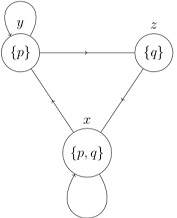Reference no: EM132505488
Question 1: This question is about tableaus. You may use either tree-like tableaus, or queue-like tableaus.
a. For each of the following propositional formulas, make and expand a tableau with the formula at the root. Use your tableau to state whether the formula is satisfiable or not. In each case find a DNF formula equivalent to the given formula. Find a simpler DNF equivalent if possible.
1. ((p V q) A (¬p V ¬q)
2. ¬((p → q) → p)
3. (((p Λ ¬q) V (¬p Λ q)) → ((p V q) Λ (¬p V ¬q)))
4. ((p → q) A (q → p)).
b. For each of the following propositional formulas, make and expand a tableau with a suitable formula at the root and use it to find a formula in conjunctive normal form (CNF) equivalent to the given formula.
1. ¬((p V q) → (p Λ q))
2. (¬(p → q) V ¬(q →. p))
3. (¬(p → q) V ¬(q → r)).
c. Let L be the first-order language with no function symbols, no constants, four unary predicates P,Q,R,S and one binary predicate B. For each of the following first order formulas, define a suitable tableau to determine whether the formula is valid or not. If the formula is not valid, use your tableau to define a structure where the formula fails to hold.
1. ∀x((P (x) V ∀y(P(y) Λ ¬∀zB(y, z))))
2. ¬(∃xP(x) Λ ∀x(P (x) → ∃yP(y))
3. ((∀x((P (x) Λ Q (x)) → R(x)) Λ ¬∃x(S(x) Λ R(x))) → ∀x((P (x) Λ Q (x)) → ¬S(x)))
Question 2. a. Consider a Kripke frame F = ({x, y, z}, {(x, x), (x, (y, (y, z), (z, x)}) and a valuation u where v (p) = {x, y}, v(q) = {x, z} shown below.

For each formula 0 below, write all worlds ω ∈ {x, y, z} for which F, v, ω |= Φ
1. p Λ ¬q Λ ◊q
2. ◊(q Λ ◊(p Λ q).
3. ◊(p → ◊p)
b. Define what it means when we say that f : F → G; is a a p-inorphisin from Kripke frame F to Kripke frame G.
c. Consider the Kripke frames (shown below)
F1 = ({x, y, z}, {(x, y), (y, Z)}), F2 = ({X) y, z}, {(x, y), (y, z), (z, x)}) and
G1 = (u, w}, {(u, w)}, G2 = ({u, v}, {(u, w), (w, w)}).
For which i, j ∈ {1, 2} is there a frame p-morphism from ri to gi? In each case either define a p-morphism or explain why there is no p-morphism.

d. A Kripke frame (V, E) is symmetric if (x, y) ∈ E → (y, x) ∈ E. Define a modal formula that is valid in a Kripke frame if and only if the Kripke frame is symmetric. Prove that your formula is valid over symmetric frames but not valid over any other frames.